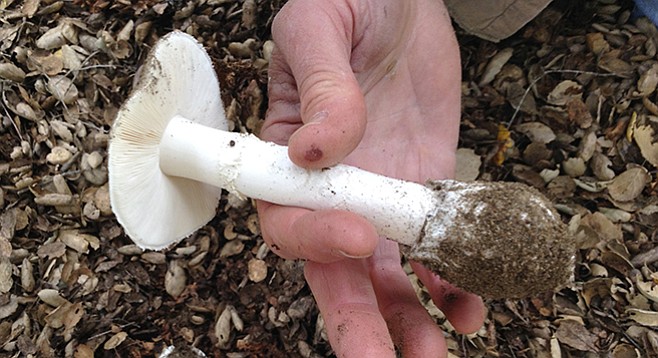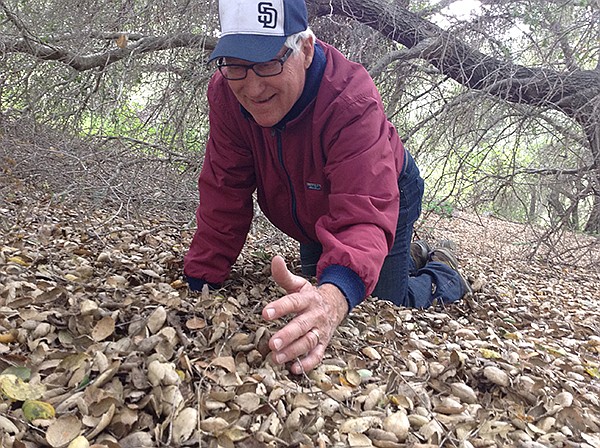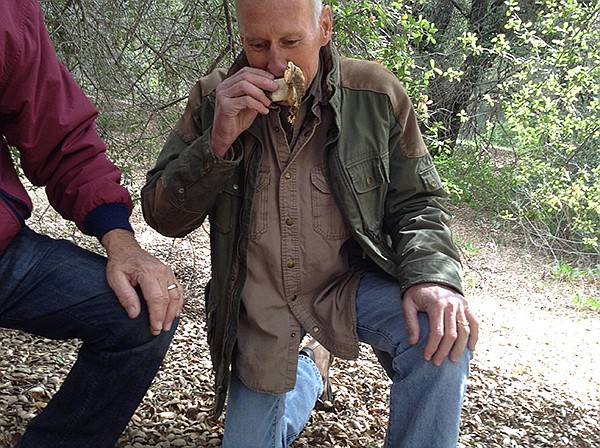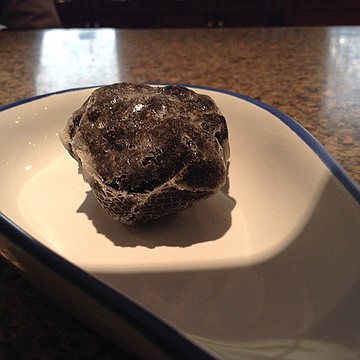 Facebook
Facebook
 X
X
 Instagram
Instagram
 TikTok
TikTok
 Youtube
Youtube

“Watch out for rattlers,” says Will.
Which is a problem, because my mycological friend Kim and I are down on our knees in the thick, soft, untrodden leaf loam they call oak duff. We’re looking for hidden things. Not rattlers, not gophers, not tarantulas — although they’re here among us — but the underground empire of mycelium, of mushrooms, here in the foothills of Mount Palomar.
“When we came last winter, we found 66 species of mushroom growing on the property,” says Kim. “But that was a wet winter.”
We’re in the forests of the Lighthouse Ranch. Will Wilson’s place. You could almost call it a wild animal park, because, deer, bobcats, mountain lions, wild pigs, and wild turkeys are all here. Will has personally met them all.
“What are we looking for again?” I ask Kim.
“Anything,” he says. “It’s been too dry. They’re not coming up.”
Then he stops. “Aha! See this? The slight rise? See how the leaves look lighter? Something’s pushing them up from below.”

And he starts burrowing, gently. I pull leaves away from my side.
“My God!” Kim exposes a tall, fresh, white mushroom under the duff, clean, and inviting.
“See the volva?” he says. He’s pointing to a kind of skirt that the stem has broken through. I reach out.
“Careful!” says Will. “Know what this is?”
“Amanita ocreata,” says Kim. “‘Destroying Angel,’ right?”
“You can touch it, you can look at it, you can even lick it for its taste, but if you swallow your saliva, it’s sayonara.”
“Deadly poisonous,” mutters Kim. “And the thing is, it looks just like quite a few edible mushrooms.”
“Why are you so into this?” I ask them both, later, back in Will’s ranch house in the trees. Their friend George, who’s the local sheriff’s assistant, lets out a laugh. “Because they’re mushroom junkies, just as fanatical as horse people are about horses.”

“They are fascinating,” says Will. “They’re like underground vultures. They clean up anything dead or rotting. They are an incredible vast organism that is actually one giant life form probably linked from coast to coast, across the continent. They clean the earth, they bring food to, for instance, my oaks. Oaks have a root zone of maybe 35 feet. Mycelium that attaches to their roots have a reach of 75 feet. They bring in nutrients. And the incredible thing is they form a communications link between trees. So if something bad happens to one tree, the mycelium somehow transmits warnings the other trees so they can put out chemical defenses. I tell you, this mycelium mega-family rules the earth. And of course, some are also delicious.”
He brings out this little shiny black thing, like a golf ball made of coal.
“Smell that. It’s not poisonous.”
I do. I get a general farmy, brewery-ish, old socks flavor. “You can eat this?

“It’s a French black truffle. It sells for $2500 per pound. This little one’s worth about $60. You should put fine shavings of it into a barely cooked omelet, or something with a mild taste, so you can appreciate its subtleties.”
Meanwhile, the Destroying Angel sits innocently white on a piece of paper on the table.
“I can see I have a ways to go,” I say.


“Watch out for rattlers,” says Will.
Which is a problem, because my mycological friend Kim and I are down on our knees in the thick, soft, untrodden leaf loam they call oak duff. We’re looking for hidden things. Not rattlers, not gophers, not tarantulas — although they’re here among us — but the underground empire of mycelium, of mushrooms, here in the foothills of Mount Palomar.
“When we came last winter, we found 66 species of mushroom growing on the property,” says Kim. “But that was a wet winter.”
We’re in the forests of the Lighthouse Ranch. Will Wilson’s place. You could almost call it a wild animal park, because, deer, bobcats, mountain lions, wild pigs, and wild turkeys are all here. Will has personally met them all.
“What are we looking for again?” I ask Kim.
“Anything,” he says. “It’s been too dry. They’re not coming up.”
Then he stops. “Aha! See this? The slight rise? See how the leaves look lighter? Something’s pushing them up from below.”

And he starts burrowing, gently. I pull leaves away from my side.
“My God!” Kim exposes a tall, fresh, white mushroom under the duff, clean, and inviting.
“See the volva?” he says. He’s pointing to a kind of skirt that the stem has broken through. I reach out.
“Careful!” says Will. “Know what this is?”
“Amanita ocreata,” says Kim. “‘Destroying Angel,’ right?”
“You can touch it, you can look at it, you can even lick it for its taste, but if you swallow your saliva, it’s sayonara.”
“Deadly poisonous,” mutters Kim. “And the thing is, it looks just like quite a few edible mushrooms.”
“Why are you so into this?” I ask them both, later, back in Will’s ranch house in the trees. Their friend George, who’s the local sheriff’s assistant, lets out a laugh. “Because they’re mushroom junkies, just as fanatical as horse people are about horses.”

“They are fascinating,” says Will. “They’re like underground vultures. They clean up anything dead or rotting. They are an incredible vast organism that is actually one giant life form probably linked from coast to coast, across the continent. They clean the earth, they bring food to, for instance, my oaks. Oaks have a root zone of maybe 35 feet. Mycelium that attaches to their roots have a reach of 75 feet. They bring in nutrients. And the incredible thing is they form a communications link between trees. So if something bad happens to one tree, the mycelium somehow transmits warnings the other trees so they can put out chemical defenses. I tell you, this mycelium mega-family rules the earth. And of course, some are also delicious.”
He brings out this little shiny black thing, like a golf ball made of coal.
“Smell that. It’s not poisonous.”
I do. I get a general farmy, brewery-ish, old socks flavor. “You can eat this?

“It’s a French black truffle. It sells for $2500 per pound. This little one’s worth about $60. You should put fine shavings of it into a barely cooked omelet, or something with a mild taste, so you can appreciate its subtleties.”
Meanwhile, the Destroying Angel sits innocently white on a piece of paper on the table.
“I can see I have a ways to go,” I say.
Comments